University Audit Report: DIPL Financial Risk Assessment and Mitigation
VerifiedAdded on 2020/02/24
|13
|2335
|71
Report
AI Summary
This report presents an audit analysis of Double Ink Printers Limited (DIPL), focusing on risk assessment and mitigation strategies. It begins with an executive summary outlining the importance of auditing in validating financial records and identifying potential fraud. The report then details the challenges faced by auditors, including the assessment of inherent and fraud risks. The analysis covers key areas such as purchase and inventory, revenue recognition, and cash receipts, while also addressing the impact of a new CEO and IT system implementation. The report identifies specific risk factors, such as changes in asset life assumptions and the introduction of a new IT system without proper testing, and proposes mitigation strategies. Furthermore, it highlights fraud risks related to segregation of duties and improper IT system implementation, suggesting measures to mitigate these risks through improved internal controls and auditor oversight. The report also includes references to relevant academic literature.
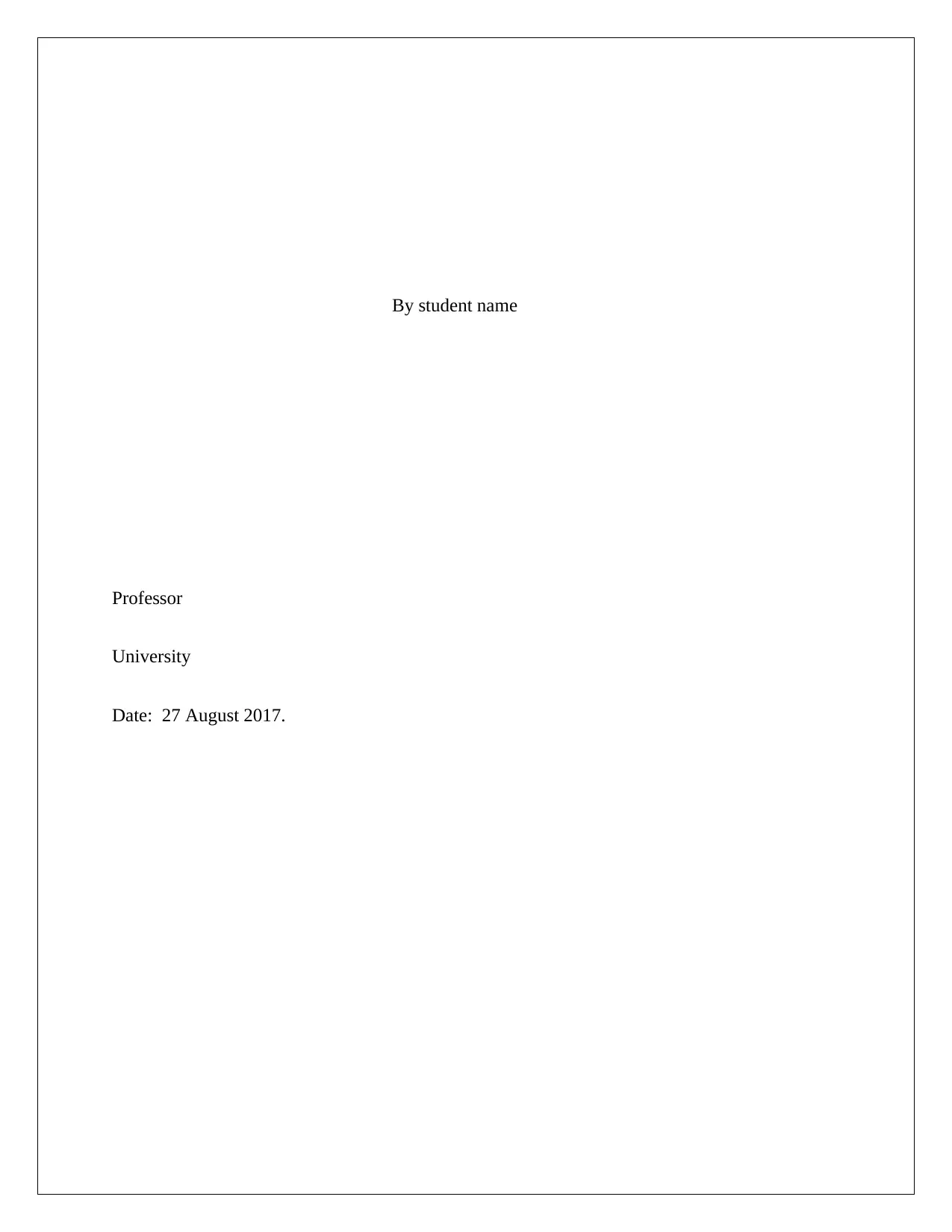
By student name
Professor
University
Date: 27 August 2017.
Professor
University
Date: 27 August 2017.
Paraphrase This Document
Need a fresh take? Get an instant paraphrase of this document with our AI Paraphraser

1
Executive Summary
Auditing is a procedure by which the auditors can comment on the validity of the books of record
prepared by the company. Risk assessment and identification is an important part of audit. While
conducting the audit the auditor must apply all substantive and analytical methods to the best of his
ability. This will help in identification of the fraud and the risks and mitigation of the same. Professional
skepticm is an important attribute of any auditor. In the given case below, the company has certain
inherent risks and certain fraud risk factors might be present. They evaluation and mitigation of the
same is given below.
1 | P a g e
Executive Summary
Auditing is a procedure by which the auditors can comment on the validity of the books of record
prepared by the company. Risk assessment and identification is an important part of audit. While
conducting the audit the auditor must apply all substantive and analytical methods to the best of his
ability. This will help in identification of the fraud and the risks and mitigation of the same. Professional
skepticm is an important attribute of any auditor. In the given case below, the company has certain
inherent risks and certain fraud risk factors might be present. They evaluation and mitigation of the
same is given below.
1 | P a g e

2
Contents
Bried facts of the case……………………………………………………….3
Question no 1…………………………………………………………………...4
Question no 2…………………………………………………………………...10
Question no 3…………………………………………………………….....….12
Refrences.....……………………………………………………………….......14
2 | P a g e
Contents
Bried facts of the case……………………………………………………….3
Question no 1…………………………………………………………………...4
Question no 2…………………………………………………………………...10
Question no 3…………………………………………………………….....….12
Refrences.....……………………………………………………………….......14
2 | P a g e
⊘ This is a preview!⊘
Do you want full access?
Subscribe today to unlock all pages.

Trusted by 1+ million students worldwide
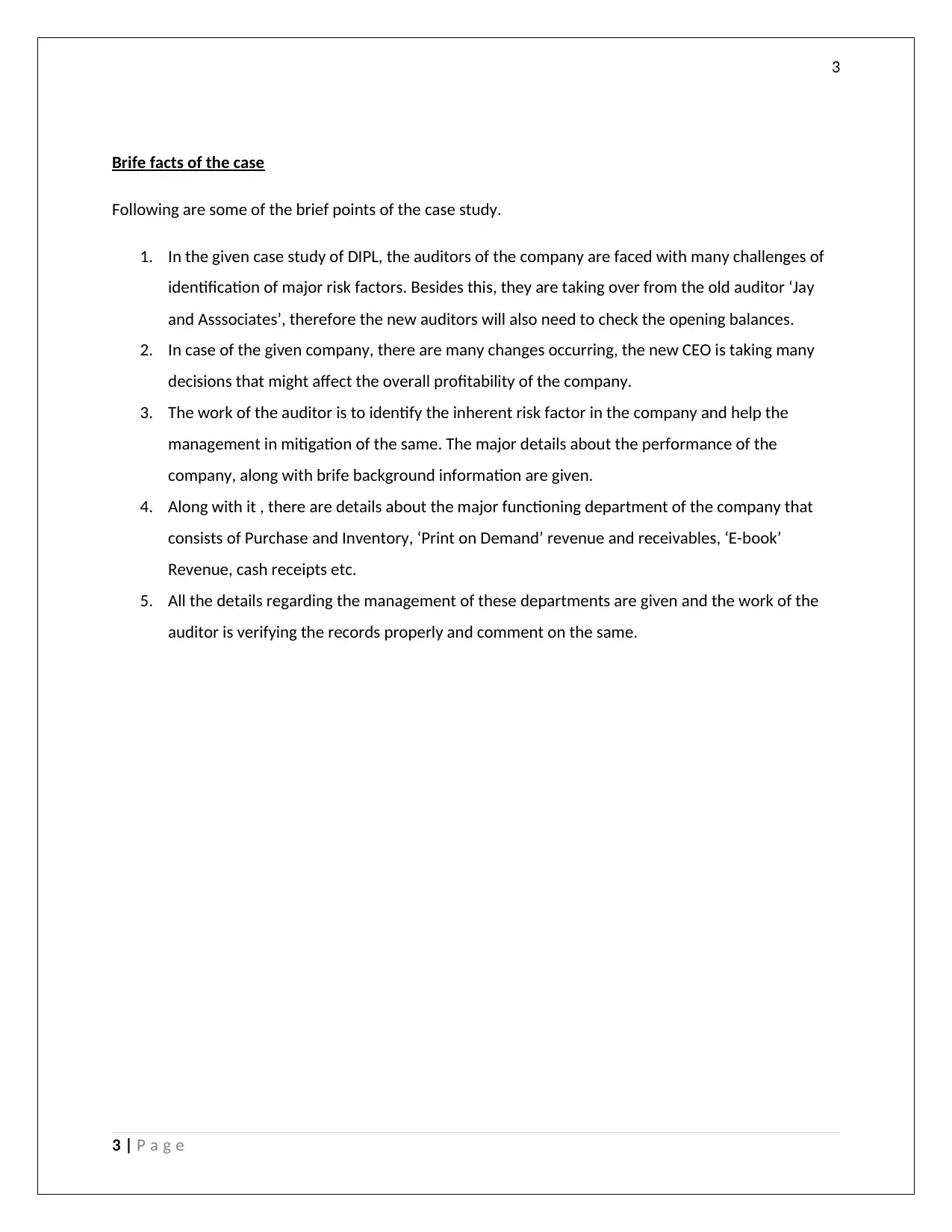
3
Brife facts of the case
Following are some of the brief points of the case study.
1. In the given case study of DIPL, the auditors of the company are faced with many challenges of
identification of major risk factors. Besides this, they are taking over from the old auditor ‘Jay
and Asssociates’, therefore the new auditors will also need to check the opening balances.
2. In case of the given company, there are many changes occurring, the new CEO is taking many
decisions that might affect the overall profitability of the company.
3. The work of the auditor is to identify the inherent risk factor in the company and help the
management in mitigation of the same. The major details about the performance of the
company, along with brife background information are given.
4. Along with it , there are details about the major functioning department of the company that
consists of Purchase and Inventory, ‘Print on Demand’ revenue and receivables, ‘E-book’
Revenue, cash receipts etc.
5. All the details regarding the management of these departments are given and the work of the
auditor is verifying the records properly and comment on the same.
3 | P a g e
Brife facts of the case
Following are some of the brief points of the case study.
1. In the given case study of DIPL, the auditors of the company are faced with many challenges of
identification of major risk factors. Besides this, they are taking over from the old auditor ‘Jay
and Asssociates’, therefore the new auditors will also need to check the opening balances.
2. In case of the given company, there are many changes occurring, the new CEO is taking many
decisions that might affect the overall profitability of the company.
3. The work of the auditor is to identify the inherent risk factor in the company and help the
management in mitigation of the same. The major details about the performance of the
company, along with brife background information are given.
4. Along with it , there are details about the major functioning department of the company that
consists of Purchase and Inventory, ‘Print on Demand’ revenue and receivables, ‘E-book’
Revenue, cash receipts etc.
5. All the details regarding the management of these departments are given and the work of the
auditor is verifying the records properly and comment on the same.
3 | P a g e
Paraphrase This Document
Need a fresh take? Get an instant paraphrase of this document with our AI Paraphraser
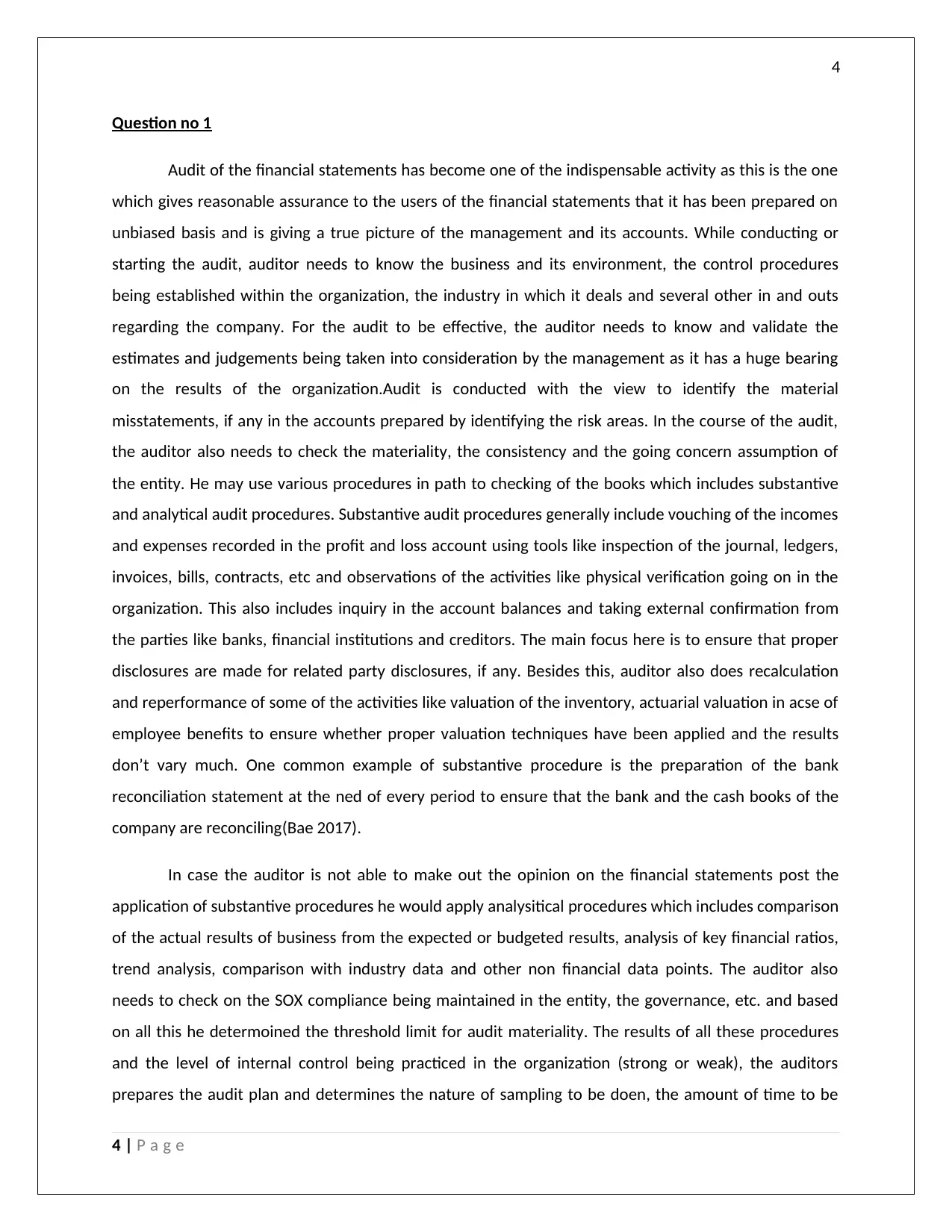
4
Question no 1
Audit of the financial statements has become one of the indispensable activity as this is the one
which gives reasonable assurance to the users of the financial statements that it has been prepared on
unbiased basis and is giving a true picture of the management and its accounts. While conducting or
starting the audit, auditor needs to know the business and its environment, the control procedures
being established within the organization, the industry in which it deals and several other in and outs
regarding the company. For the audit to be effective, the auditor needs to know and validate the
estimates and judgements being taken into consideration by the management as it has a huge bearing
on the results of the organization.Audit is conducted with the view to identify the material
misstatements, if any in the accounts prepared by identifying the risk areas. In the course of the audit,
the auditor also needs to check the materiality, the consistency and the going concern assumption of
the entity. He may use various procedures in path to checking of the books which includes substantive
and analytical audit procedures. Substantive audit procedures generally include vouching of the incomes
and expenses recorded in the profit and loss account using tools like inspection of the journal, ledgers,
invoices, bills, contracts, etc and observations of the activities like physical verification going on in the
organization. This also includes inquiry in the account balances and taking external confirmation from
the parties like banks, financial institutions and creditors. The main focus here is to ensure that proper
disclosures are made for related party disclosures, if any. Besides this, auditor also does recalculation
and reperformance of some of the activities like valuation of the inventory, actuarial valuation in acse of
employee benefits to ensure whether proper valuation techniques have been applied and the results
don’t vary much. One common example of substantive procedure is the preparation of the bank
reconciliation statement at the ned of every period to ensure that the bank and the cash books of the
company are reconciling(Bae 2017).
In case the auditor is not able to make out the opinion on the financial statements post the
application of substantive procedures he would apply analysitical procedures which includes comparison
of the actual results of business from the expected or budgeted results, analysis of key financial ratios,
trend analysis, comparison with industry data and other non financial data points. The auditor also
needs to check on the SOX compliance being maintained in the entity, the governance, etc. and based
on all this he determoined the threshold limit for audit materiality. The results of all these procedures
and the level of internal control being practiced in the organization (strong or weak), the auditors
prepares the audit plan and determines the nature of sampling to be doen, the amount of time to be
4 | P a g e
Question no 1
Audit of the financial statements has become one of the indispensable activity as this is the one
which gives reasonable assurance to the users of the financial statements that it has been prepared on
unbiased basis and is giving a true picture of the management and its accounts. While conducting or
starting the audit, auditor needs to know the business and its environment, the control procedures
being established within the organization, the industry in which it deals and several other in and outs
regarding the company. For the audit to be effective, the auditor needs to know and validate the
estimates and judgements being taken into consideration by the management as it has a huge bearing
on the results of the organization.Audit is conducted with the view to identify the material
misstatements, if any in the accounts prepared by identifying the risk areas. In the course of the audit,
the auditor also needs to check the materiality, the consistency and the going concern assumption of
the entity. He may use various procedures in path to checking of the books which includes substantive
and analytical audit procedures. Substantive audit procedures generally include vouching of the incomes
and expenses recorded in the profit and loss account using tools like inspection of the journal, ledgers,
invoices, bills, contracts, etc and observations of the activities like physical verification going on in the
organization. This also includes inquiry in the account balances and taking external confirmation from
the parties like banks, financial institutions and creditors. The main focus here is to ensure that proper
disclosures are made for related party disclosures, if any. Besides this, auditor also does recalculation
and reperformance of some of the activities like valuation of the inventory, actuarial valuation in acse of
employee benefits to ensure whether proper valuation techniques have been applied and the results
don’t vary much. One common example of substantive procedure is the preparation of the bank
reconciliation statement at the ned of every period to ensure that the bank and the cash books of the
company are reconciling(Bae 2017).
In case the auditor is not able to make out the opinion on the financial statements post the
application of substantive procedures he would apply analysitical procedures which includes comparison
of the actual results of business from the expected or budgeted results, analysis of key financial ratios,
trend analysis, comparison with industry data and other non financial data points. The auditor also
needs to check on the SOX compliance being maintained in the entity, the governance, etc. and based
on all this he determoined the threshold limit for audit materiality. The results of all these procedures
and the level of internal control being practiced in the organization (strong or weak), the auditors
prepares the audit plan and determines the nature of sampling to be doen, the amount of time to be
4 | P a g e
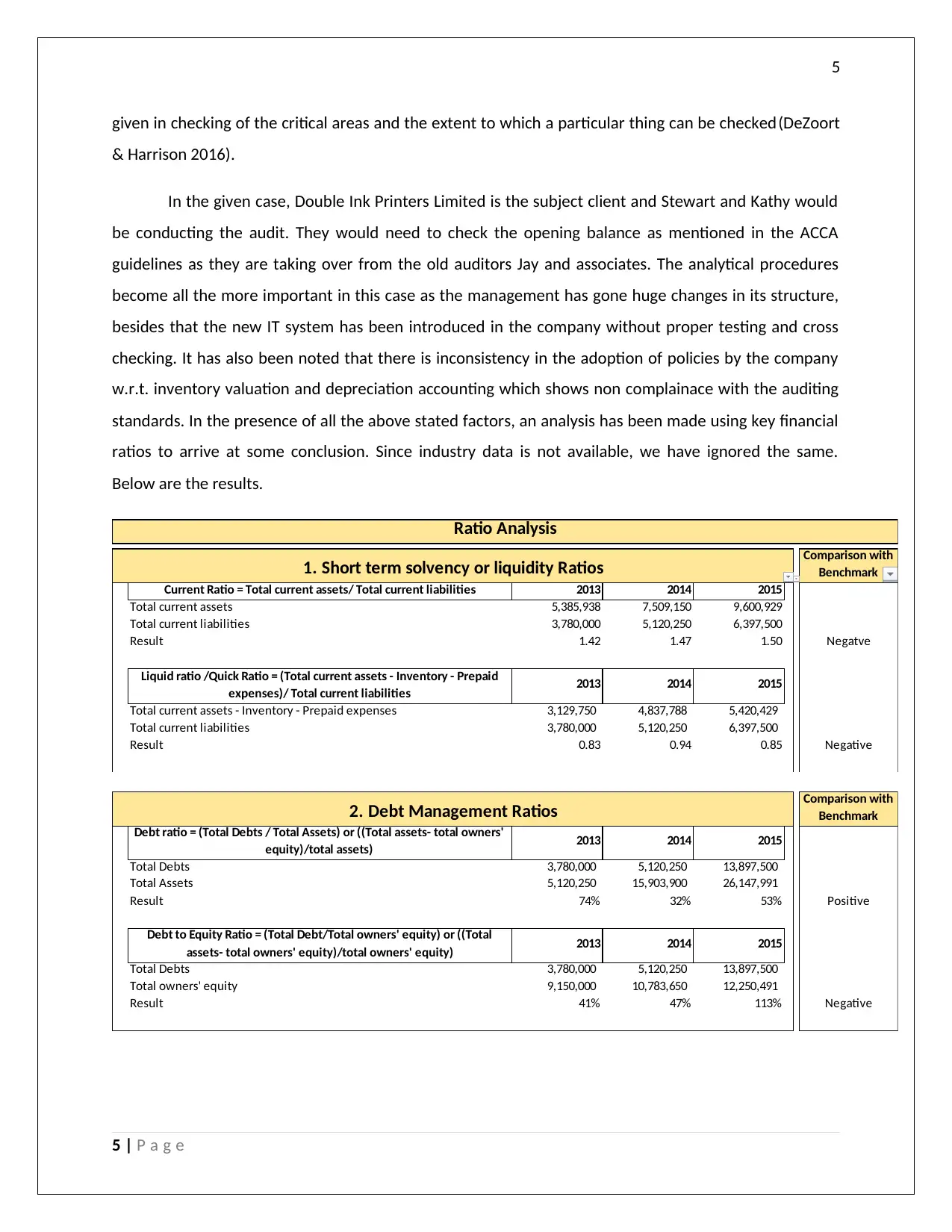
5
given in checking of the critical areas and the extent to which a particular thing can be checked(DeZoort
& Harrison 2016).
In the given case, Double Ink Printers Limited is the subject client and Stewart and Kathy would
be conducting the audit. They would need to check the opening balance as mentioned in the ACCA
guidelines as they are taking over from the old auditors Jay and associates. The analytical procedures
become all the more important in this case as the management has gone huge changes in its structure,
besides that the new IT system has been introduced in the company without proper testing and cross
checking. It has also been noted that there is inconsistency in the adoption of policies by the company
w.r.t. inventory valuation and depreciation accounting which shows non complainace with the auditing
standards. In the presence of all the above stated factors, an analysis has been made using key financial
ratios to arrive at some conclusion. Since industry data is not available, we have ignored the same.
Below are the results.
Comparison with
Benchmark
2013 2014 2015
Total current assets 5,385,938 7,509,150 9,600,929
Total current liabilities 3,780,000 5,120,250 6,397,500
Result 1.42 1.47 1.50 Negatve
2013 2014 2015
Total current assets - Inventory - Prepaid expenses 3,129,750 4,837,788 5,420,429
Total current liabilities 3,780,000 5,120,250 6,397,500
Result 0.83 0.94 0.85 Negative
Current Ratio = Total current assets/ Total current liabilities
Liquid ratio /Quick Ratio = (Total current assets - Inventory - Prepaid
expenses)/ Total current liabilities
1. Short term solvency or liquidity Ratios
Ratio Analysis
Comparison with
Benchmark
2013 2014 2015
Total Debts 3,780,000 5,120,250 13,897,500
Total Assets 5,120,250 15,903,900 26,147,991
Result 74% 32% 53% Positive
2013 2014 2015
Total Debts 3,780,000 5,120,250 13,897,500
Total owners' equity 9,150,000 10,783,650 12,250,491
Result 41% 47% 113% Negative
Debt ratio = (Total Debts / Total Assets) or ((Total assets- total owners'
equity)/total assets)
Debt to Equity Ratio = (Total Debt/Total owners' equity) or ((Total
assets- total owners' equity)/total owners' equity)
2. Debt Management Ratios
5 | P a g e
given in checking of the critical areas and the extent to which a particular thing can be checked(DeZoort
& Harrison 2016).
In the given case, Double Ink Printers Limited is the subject client and Stewart and Kathy would
be conducting the audit. They would need to check the opening balance as mentioned in the ACCA
guidelines as they are taking over from the old auditors Jay and associates. The analytical procedures
become all the more important in this case as the management has gone huge changes in its structure,
besides that the new IT system has been introduced in the company without proper testing and cross
checking. It has also been noted that there is inconsistency in the adoption of policies by the company
w.r.t. inventory valuation and depreciation accounting which shows non complainace with the auditing
standards. In the presence of all the above stated factors, an analysis has been made using key financial
ratios to arrive at some conclusion. Since industry data is not available, we have ignored the same.
Below are the results.
Comparison with
Benchmark
2013 2014 2015
Total current assets 5,385,938 7,509,150 9,600,929
Total current liabilities 3,780,000 5,120,250 6,397,500
Result 1.42 1.47 1.50 Negatve
2013 2014 2015
Total current assets - Inventory - Prepaid expenses 3,129,750 4,837,788 5,420,429
Total current liabilities 3,780,000 5,120,250 6,397,500
Result 0.83 0.94 0.85 Negative
Current Ratio = Total current assets/ Total current liabilities
Liquid ratio /Quick Ratio = (Total current assets - Inventory - Prepaid
expenses)/ Total current liabilities
1. Short term solvency or liquidity Ratios
Ratio Analysis
Comparison with
Benchmark
2013 2014 2015
Total Debts 3,780,000 5,120,250 13,897,500
Total Assets 5,120,250 15,903,900 26,147,991
Result 74% 32% 53% Positive
2013 2014 2015
Total Debts 3,780,000 5,120,250 13,897,500
Total owners' equity 9,150,000 10,783,650 12,250,491
Result 41% 47% 113% Negative
Debt ratio = (Total Debts / Total Assets) or ((Total assets- total owners'
equity)/total assets)
Debt to Equity Ratio = (Total Debt/Total owners' equity) or ((Total
assets- total owners' equity)/total owners' equity)
2. Debt Management Ratios
5 | P a g e
⊘ This is a preview!⊘
Do you want full access?
Subscribe today to unlock all pages.

Trusted by 1+ million students worldwide
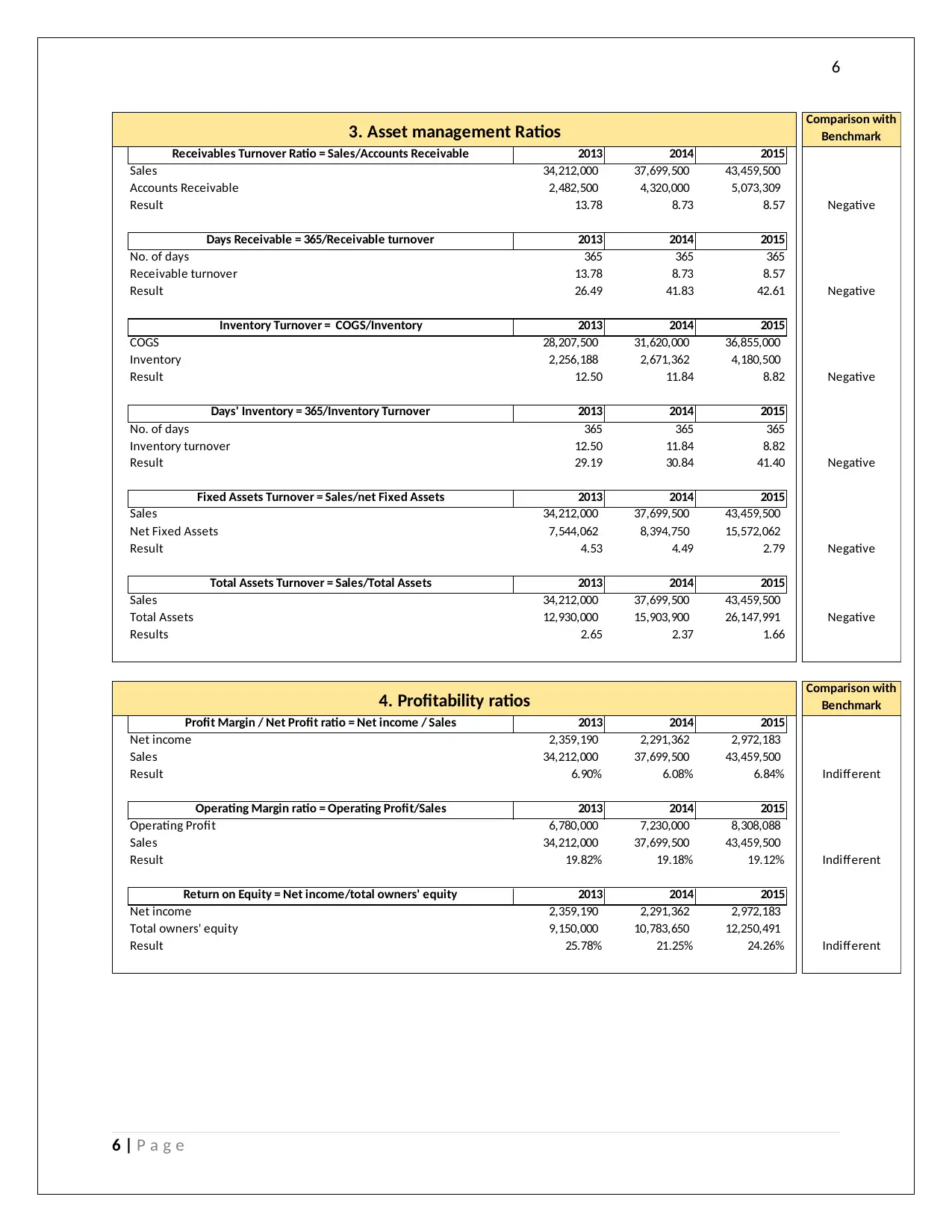
6
Comparison with
Benchmark
2013 2014 2015
Sales 34,212,000 37,699,500 43,459,500
Accounts Receivable 2,482,500 4,320,000 5,073,309
Result 13.78 8.73 8.57 Negative
2013 2014 2015
No. of days 365 365 365
Receivable turnover 13.78 8.73 8.57
Result 26.49 41.83 42.61 Negative
2013 2014 2015
COGS 28,207,500 31,620,000 36,855,000
Inventory 2,256,188 2,671,362 4,180,500
Result 12.50 11.84 8.82 Negative
2013 2014 2015
No. of days 365 365 365
Inventory turnover 12.50 11.84 8.82
Result 29.19 30.84 41.40 Negative
2013 2014 2015
Sales 34,212,000 37,699,500 43,459,500
Net Fixed Assets 7,544,062 8,394,750 15,572,062
Result 4.53 4.49 2.79 Negative
2013 2014 2015
Sales 34,212,000 37,699,500 43,459,500
Total Assets 12,930,000 15,903,900 26,147,991 Negative
Results 2.65 2.37 1.66
Inventory Turnover = COGS/Inventory
Days' Inventory = 365/Inventory Turnover
Fixed Assets Turnover = Sales/net Fixed Assets
Total Assets Turnover = Sales/Total Assets
Receivables Turnover Ratio = Sales/Accounts Receivable
Days Receivable = 365/Receivable turnover
3. Asset management Ratios
Comparison with
Benchmark
2013 2014 2015
Net income 2,359,190 2,291,362 2,972,183
Sales 34,212,000 37,699,500 43,459,500
Result 6.90% 6.08% 6.84% Indifferent
2013 2014 2015
Operating Profit 6,780,000 7,230,000 8,308,088
Sales 34,212,000 37,699,500 43,459,500
Result 19.82% 19.18% 19.12% Indifferent
2013 2014 2015
Net income 2,359,190 2,291,362 2,972,183
Total owners' equity 9,150,000 10,783,650 12,250,491
Result 25.78% 21.25% 24.26% Indifferent
Profit Margin / Net Profit ratio = Net income / Sales
Operating Margin ratio = Operating Profit/Sales
Return on Equity = Net income/total owners' equity
4. Profitability ratios
6 | P a g e
Comparison with
Benchmark
2013 2014 2015
Sales 34,212,000 37,699,500 43,459,500
Accounts Receivable 2,482,500 4,320,000 5,073,309
Result 13.78 8.73 8.57 Negative
2013 2014 2015
No. of days 365 365 365
Receivable turnover 13.78 8.73 8.57
Result 26.49 41.83 42.61 Negative
2013 2014 2015
COGS 28,207,500 31,620,000 36,855,000
Inventory 2,256,188 2,671,362 4,180,500
Result 12.50 11.84 8.82 Negative
2013 2014 2015
No. of days 365 365 365
Inventory turnover 12.50 11.84 8.82
Result 29.19 30.84 41.40 Negative
2013 2014 2015
Sales 34,212,000 37,699,500 43,459,500
Net Fixed Assets 7,544,062 8,394,750 15,572,062
Result 4.53 4.49 2.79 Negative
2013 2014 2015
Sales 34,212,000 37,699,500 43,459,500
Total Assets 12,930,000 15,903,900 26,147,991 Negative
Results 2.65 2.37 1.66
Inventory Turnover = COGS/Inventory
Days' Inventory = 365/Inventory Turnover
Fixed Assets Turnover = Sales/net Fixed Assets
Total Assets Turnover = Sales/Total Assets
Receivables Turnover Ratio = Sales/Accounts Receivable
Days Receivable = 365/Receivable turnover
3. Asset management Ratios
Comparison with
Benchmark
2013 2014 2015
Net income 2,359,190 2,291,362 2,972,183
Sales 34,212,000 37,699,500 43,459,500
Result 6.90% 6.08% 6.84% Indifferent
2013 2014 2015
Operating Profit 6,780,000 7,230,000 8,308,088
Sales 34,212,000 37,699,500 43,459,500
Result 19.82% 19.18% 19.12% Indifferent
2013 2014 2015
Net income 2,359,190 2,291,362 2,972,183
Total owners' equity 9,150,000 10,783,650 12,250,491
Result 25.78% 21.25% 24.26% Indifferent
Profit Margin / Net Profit ratio = Net income / Sales
Operating Margin ratio = Operating Profit/Sales
Return on Equity = Net income/total owners' equity
4. Profitability ratios
6 | P a g e
Paraphrase This Document
Need a fresh take? Get an instant paraphrase of this document with our AI Paraphraser
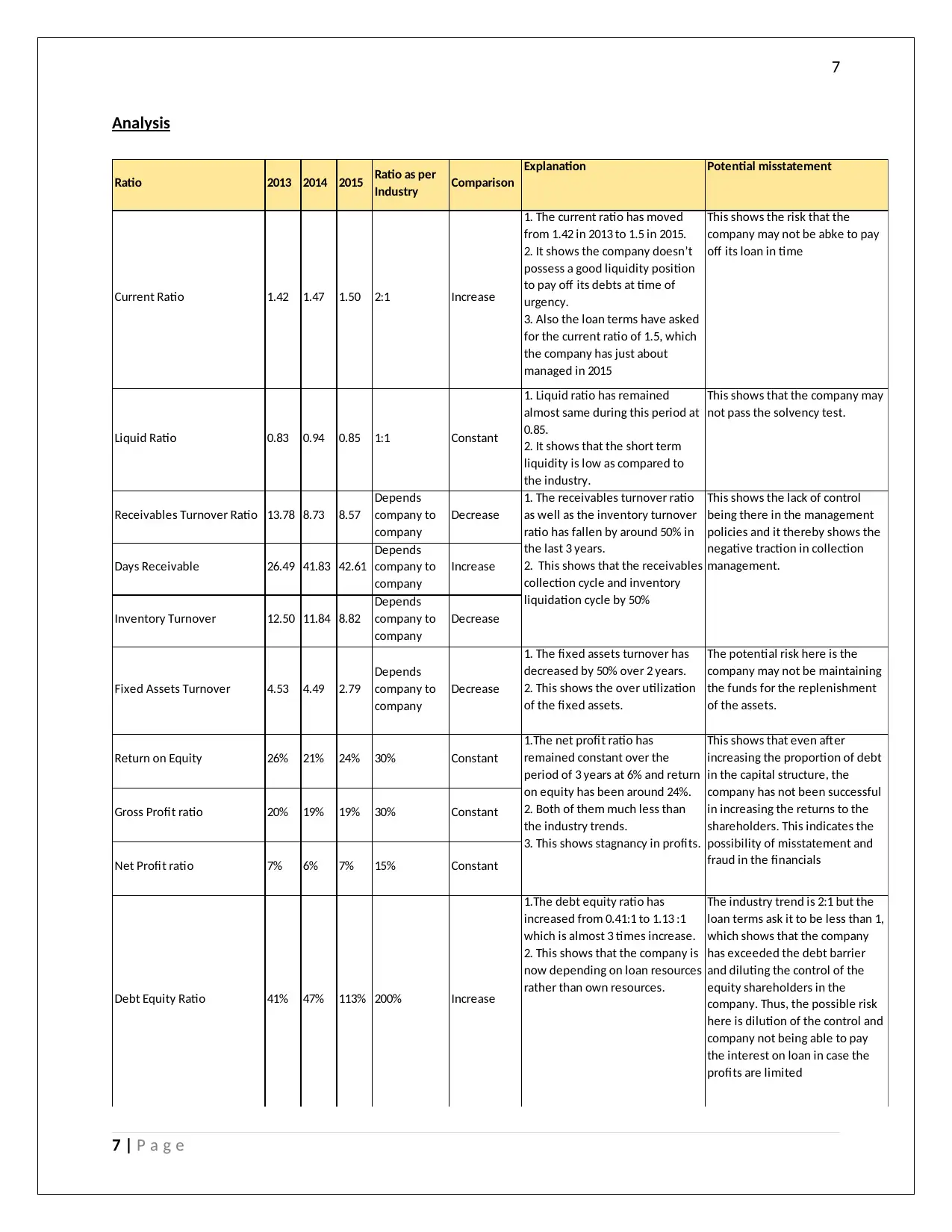
7
Analysis
Ratio 2013 2014 2015 Ratio as per
Industry Comparison
Explanation Potential misstatement
Current Ratio 1.42 1.47 1.50 2:1 Increase
1. The current ratio has moved
from 1.42 in 2013 to 1.5 in 2015.
2. It shows the company doesn’t
possess a good liquidity position
to pay off its debts at time of
urgency.
3. Also the loan terms have asked
for the current ratio of 1.5, which
the company has just about
managed in 2015
This shows the risk that the
company may not be abke to pay
off its loan in time
Liquid Ratio 0.83 0.94 0.85 1:1 Constant
1. Liquid ratio has remained
almost same during this period at
0.85.
2. It shows that the short term
liquidity is low as compared to
the industry.
This shows that the company may
not pass the solvency test.
Receivables Turnover Ratio 13.78 8.73 8.57
Depends
company to
company
Decrease
Days Receivable 26.49 41.83 42.61
Depends
company to
company
Increase
Inventory Turnover 12.50 11.84 8.82
Depends
company to
company
Decrease
Fixed Assets Turnover 4.53 4.49 2.79
Depends
company to
company
Decrease
1. The fixed assets turnover has
decreased by 50% over 2 years.
2. This shows the over utilization
of the fixed assets.
The potential risk here is the
company may not be maintaining
the funds for the replenishment
of the assets.
Return on Equity 26% 21% 24% 30% Constant
Gross Profit ratio 20% 19% 19% 30% Constant
Net Profit ratio 7% 6% 7% 15% Constant
Debt Equity Ratio 41% 47% 113% 200% Increase
1.The debt equity ratio has
increased from 0.41:1 to 1.13 :1
which is almost 3 times increase.
2. This shows that the company is
now depending on loan resources
rather than own resources.
The industry trend is 2:1 but the
loan terms ask it to be less than 1,
which shows that the company
has exceeded the debt barrier
and diluting the control of the
equity shareholders in the
company. Thus, the possible risk
here is dilution of the control and
company not being able to pay
the interest on loan in case the
profits are limited
1. The receivables turnover ratio
as well as the inventory turnover
ratio has fallen by around 50% in
the last 3 years.
2. This shows that the receivables
collection cycle and inventory
liquidation cycle by 50%
This shows the lack of control
being there in the management
policies and it thereby shows the
negative traction in collection
management.
1.The net profit ratio has
remained constant over the
period of 3 years at 6% and return
on equity has been around 24%.
2. Both of them much less than
the industry trends.
3. This shows stagnancy in profits.
This shows that even after
increasing the proportion of debt
in the capital structure, the
company has not been successful
in increasing the returns to the
shareholders. This indicates the
possibility of misstatement and
fraud in the financials
7 | P a g e
Analysis
Ratio 2013 2014 2015 Ratio as per
Industry Comparison
Explanation Potential misstatement
Current Ratio 1.42 1.47 1.50 2:1 Increase
1. The current ratio has moved
from 1.42 in 2013 to 1.5 in 2015.
2. It shows the company doesn’t
possess a good liquidity position
to pay off its debts at time of
urgency.
3. Also the loan terms have asked
for the current ratio of 1.5, which
the company has just about
managed in 2015
This shows the risk that the
company may not be abke to pay
off its loan in time
Liquid Ratio 0.83 0.94 0.85 1:1 Constant
1. Liquid ratio has remained
almost same during this period at
0.85.
2. It shows that the short term
liquidity is low as compared to
the industry.
This shows that the company may
not pass the solvency test.
Receivables Turnover Ratio 13.78 8.73 8.57
Depends
company to
company
Decrease
Days Receivable 26.49 41.83 42.61
Depends
company to
company
Increase
Inventory Turnover 12.50 11.84 8.82
Depends
company to
company
Decrease
Fixed Assets Turnover 4.53 4.49 2.79
Depends
company to
company
Decrease
1. The fixed assets turnover has
decreased by 50% over 2 years.
2. This shows the over utilization
of the fixed assets.
The potential risk here is the
company may not be maintaining
the funds for the replenishment
of the assets.
Return on Equity 26% 21% 24% 30% Constant
Gross Profit ratio 20% 19% 19% 30% Constant
Net Profit ratio 7% 6% 7% 15% Constant
Debt Equity Ratio 41% 47% 113% 200% Increase
1.The debt equity ratio has
increased from 0.41:1 to 1.13 :1
which is almost 3 times increase.
2. This shows that the company is
now depending on loan resources
rather than own resources.
The industry trend is 2:1 but the
loan terms ask it to be less than 1,
which shows that the company
has exceeded the debt barrier
and diluting the control of the
equity shareholders in the
company. Thus, the possible risk
here is dilution of the control and
company not being able to pay
the interest on loan in case the
profits are limited
1. The receivables turnover ratio
as well as the inventory turnover
ratio has fallen by around 50% in
the last 3 years.
2. This shows that the receivables
collection cycle and inventory
liquidation cycle by 50%
This shows the lack of control
being there in the management
policies and it thereby shows the
negative traction in collection
management.
1.The net profit ratio has
remained constant over the
period of 3 years at 6% and return
on equity has been around 24%.
2. Both of them much less than
the industry trends.
3. This shows stagnancy in profits.
This shows that even after
increasing the proportion of debt
in the capital structure, the
company has not been successful
in increasing the returns to the
shareholders. This indicates the
possibility of misstatement and
fraud in the financials
7 | P a g e

8
Solution 2
s.no Issue Involved Type of risk Reason of risk Mitigation of risk
1 The first case is where
the management of the
company, indulges in
certain activities that are
different from the
routine nature of work.
It is type of inherent
risk that is associated
with changes in the
overall procedures of
an organisation.
The life of the asset as
per the industrial
regulation is 30 years,
but the company must
to consider the life as 20
years. The management
is not taking the decision
based on any research
that has been conducted
by the management, but
based on its own
knowledge. The main
risk factor is that there
might be over valuation
or the undervaluation of
the assets that might
affect the overall
functioning of the
company. Thus, it is
important that proper
research must be done
before undertaking such
assumptions(Knechel &
Salterio 2016)
The auditor can
mitigate the risk,
by asking the
management to
undertake proper
research before
making such
changes. It is
important proper
disclosures
regarding all the
major changes are
properly given by
the auditor so that
the financial
statements show
the true state pouf
affairs of the
company(Fay &
Negangard 2017).
2 The second issue is
associated with the
launching of the new IT
system.
It is type of risk that
is associated with
change in the
current procedures
without undertaking
The system is entirely
new, the amazement is
not familiar with the
kind of value it will
generate. There are high
The auditor can
mitigate the risk
by asking the man
agent to provide
with all the valid
8 | P a g e
Solution 2
s.no Issue Involved Type of risk Reason of risk Mitigation of risk
1 The first case is where
the management of the
company, indulges in
certain activities that are
different from the
routine nature of work.
It is type of inherent
risk that is associated
with changes in the
overall procedures of
an organisation.
The life of the asset as
per the industrial
regulation is 30 years,
but the company must
to consider the life as 20
years. The management
is not taking the decision
based on any research
that has been conducted
by the management, but
based on its own
knowledge. The main
risk factor is that there
might be over valuation
or the undervaluation of
the assets that might
affect the overall
functioning of the
company. Thus, it is
important that proper
research must be done
before undertaking such
assumptions(Knechel &
Salterio 2016)
The auditor can
mitigate the risk,
by asking the
management to
undertake proper
research before
making such
changes. It is
important proper
disclosures
regarding all the
major changes are
properly given by
the auditor so that
the financial
statements show
the true state pouf
affairs of the
company(Fay &
Negangard 2017).
2 The second issue is
associated with the
launching of the new IT
system.
It is type of risk that
is associated with
change in the
current procedures
without undertaking
The system is entirely
new, the amazement is
not familiar with the
kind of value it will
generate. There are high
The auditor can
mitigate the risk
by asking the man
agent to provide
with all the valid
8 | P a g e
⊘ This is a preview!⊘
Do you want full access?
Subscribe today to unlock all pages.

Trusted by 1+ million students worldwide

9
proper research. chances that since the
management have not
done roper
reconciliation and have
not adopted proper
measures to make sure
that the system is
functioning properly. It
exposes the company to
the element of inherent
risk. Thus, it is important
that before taking steps,
proper precautions must
be undertaken so that
the company can avoid
kind of material
misstatement. The
auditor must also checks
the records properly and
asks the management to
provide him with proper
details. All the elements
of risk must be properly
identified and
eliminated by the
company(Raiborn, Butler
& Martin 2016)
details regarding
the new system
and also thy must
undertake proper
research before
undertaking so.
These are the few
areas where there
is presence of
inherent risk in
the overall
functioning of the
company. These
occur even in the
presence of
proper control
factors, but the
management
should try to make
the control more
strong so that all
such risk can be
reduced(Sonu,
Ahn & Choi 2017).
9 | P a g e
proper research. chances that since the
management have not
done roper
reconciliation and have
not adopted proper
measures to make sure
that the system is
functioning properly. It
exposes the company to
the element of inherent
risk. Thus, it is important
that before taking steps,
proper precautions must
be undertaken so that
the company can avoid
kind of material
misstatement. The
auditor must also checks
the records properly and
asks the management to
provide him with proper
details. All the elements
of risk must be properly
identified and
eliminated by the
company(Raiborn, Butler
& Martin 2016)
details regarding
the new system
and also thy must
undertake proper
research before
undertaking so.
These are the few
areas where there
is presence of
inherent risk in
the overall
functioning of the
company. These
occur even in the
presence of
proper control
factors, but the
management
should try to make
the control more
strong so that all
such risk can be
reduced(Sonu,
Ahn & Choi 2017).
9 | P a g e
Paraphrase This Document
Need a fresh take? Get an instant paraphrase of this document with our AI Paraphraser
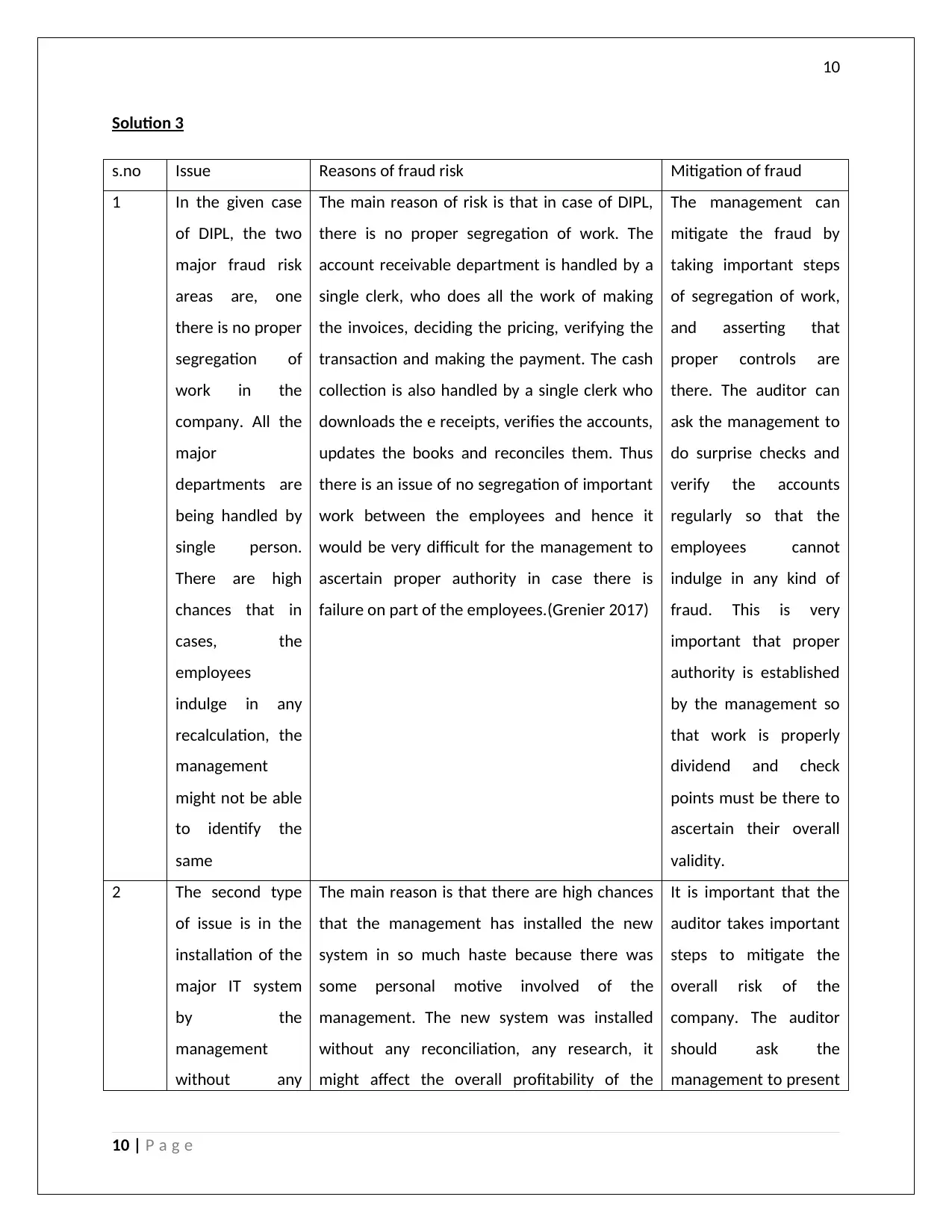
10
Solution 3
s.no Issue Reasons of fraud risk Mitigation of fraud
1 In the given case
of DIPL, the two
major fraud risk
areas are, one
there is no proper
segregation of
work in the
company. All the
major
departments are
being handled by
single person.
There are high
chances that in
cases, the
employees
indulge in any
recalculation, the
management
might not be able
to identify the
same
The main reason of risk is that in case of DIPL,
there is no proper segregation of work. The
account receivable department is handled by a
single clerk, who does all the work of making
the invoices, deciding the pricing, verifying the
transaction and making the payment. The cash
collection is also handled by a single clerk who
downloads the e receipts, verifies the accounts,
updates the books and reconciles them. Thus
there is an issue of no segregation of important
work between the employees and hence it
would be very difficult for the management to
ascertain proper authority in case there is
failure on part of the employees.(Grenier 2017)
The management can
mitigate the fraud by
taking important steps
of segregation of work,
and asserting that
proper controls are
there. The auditor can
ask the management to
do surprise checks and
verify the accounts
regularly so that the
employees cannot
indulge in any kind of
fraud. This is very
important that proper
authority is established
by the management so
that work is properly
dividend and check
points must be there to
ascertain their overall
validity.
2 The second type
of issue is in the
installation of the
major IT system
by the
management
without any
The main reason is that there are high chances
that the management has installed the new
system in so much haste because there was
some personal motive involved of the
management. The new system was installed
without any reconciliation, any research, it
might affect the overall profitability of the
It is important that the
auditor takes important
steps to mitigate the
overall risk of the
company. The auditor
should ask the
management to present
10 | P a g e
Solution 3
s.no Issue Reasons of fraud risk Mitigation of fraud
1 In the given case
of DIPL, the two
major fraud risk
areas are, one
there is no proper
segregation of
work in the
company. All the
major
departments are
being handled by
single person.
There are high
chances that in
cases, the
employees
indulge in any
recalculation, the
management
might not be able
to identify the
same
The main reason of risk is that in case of DIPL,
there is no proper segregation of work. The
account receivable department is handled by a
single clerk, who does all the work of making
the invoices, deciding the pricing, verifying the
transaction and making the payment. The cash
collection is also handled by a single clerk who
downloads the e receipts, verifies the accounts,
updates the books and reconciles them. Thus
there is an issue of no segregation of important
work between the employees and hence it
would be very difficult for the management to
ascertain proper authority in case there is
failure on part of the employees.(Grenier 2017)
The management can
mitigate the fraud by
taking important steps
of segregation of work,
and asserting that
proper controls are
there. The auditor can
ask the management to
do surprise checks and
verify the accounts
regularly so that the
employees cannot
indulge in any kind of
fraud. This is very
important that proper
authority is established
by the management so
that work is properly
dividend and check
points must be there to
ascertain their overall
validity.
2 The second type
of issue is in the
installation of the
major IT system
by the
management
without any
The main reason is that there are high chances
that the management has installed the new
system in so much haste because there was
some personal motive involved of the
management. The new system was installed
without any reconciliation, any research, it
might affect the overall profitability of the
It is important that the
auditor takes important
steps to mitigate the
overall risk of the
company. The auditor
should ask the
management to present
10 | P a g e
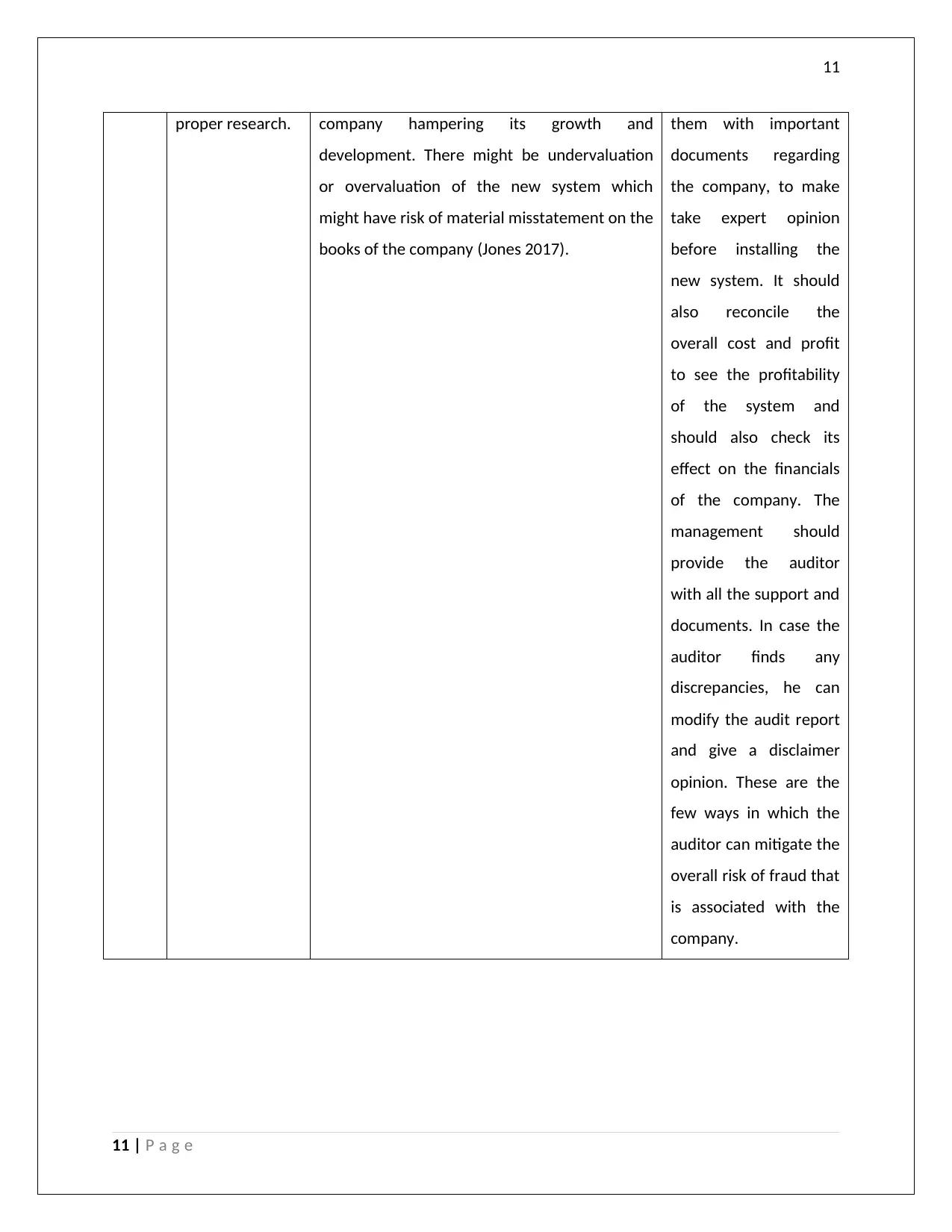
11
proper research. company hampering its growth and
development. There might be undervaluation
or overvaluation of the new system which
might have risk of material misstatement on the
books of the company (Jones 2017).
them with important
documents regarding
the company, to make
take expert opinion
before installing the
new system. It should
also reconcile the
overall cost and profit
to see the profitability
of the system and
should also check its
effect on the financials
of the company. The
management should
provide the auditor
with all the support and
documents. In case the
auditor finds any
discrepancies, he can
modify the audit report
and give a disclaimer
opinion. These are the
few ways in which the
auditor can mitigate the
overall risk of fraud that
is associated with the
company.
11 | P a g e
proper research. company hampering its growth and
development. There might be undervaluation
or overvaluation of the new system which
might have risk of material misstatement on the
books of the company (Jones 2017).
them with important
documents regarding
the company, to make
take expert opinion
before installing the
new system. It should
also reconcile the
overall cost and profit
to see the profitability
of the system and
should also check its
effect on the financials
of the company. The
management should
provide the auditor
with all the support and
documents. In case the
auditor finds any
discrepancies, he can
modify the audit report
and give a disclaimer
opinion. These are the
few ways in which the
auditor can mitigate the
overall risk of fraud that
is associated with the
company.
11 | P a g e
⊘ This is a preview!⊘
Do you want full access?
Subscribe today to unlock all pages.

Trusted by 1+ million students worldwide
1 out of 13
Related Documents
Your All-in-One AI-Powered Toolkit for Academic Success.
+13062052269
info@desklib.com
Available 24*7 on WhatsApp / Email
![[object Object]](/_next/static/media/star-bottom.7253800d.svg)
Unlock your academic potential
Copyright © 2020–2025 A2Z Services. All Rights Reserved. Developed and managed by ZUCOL.




